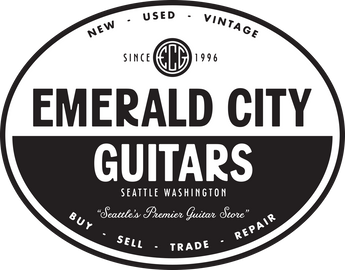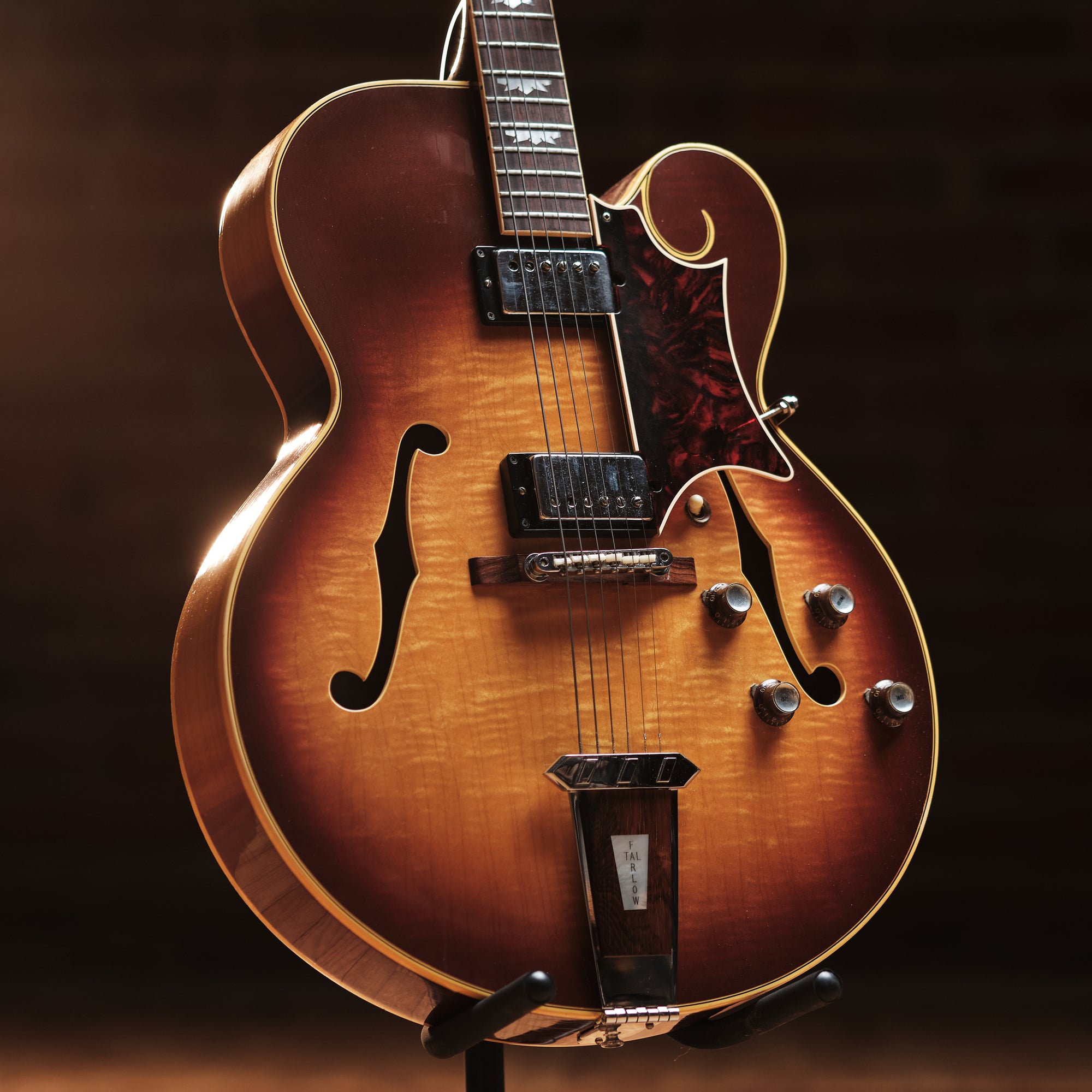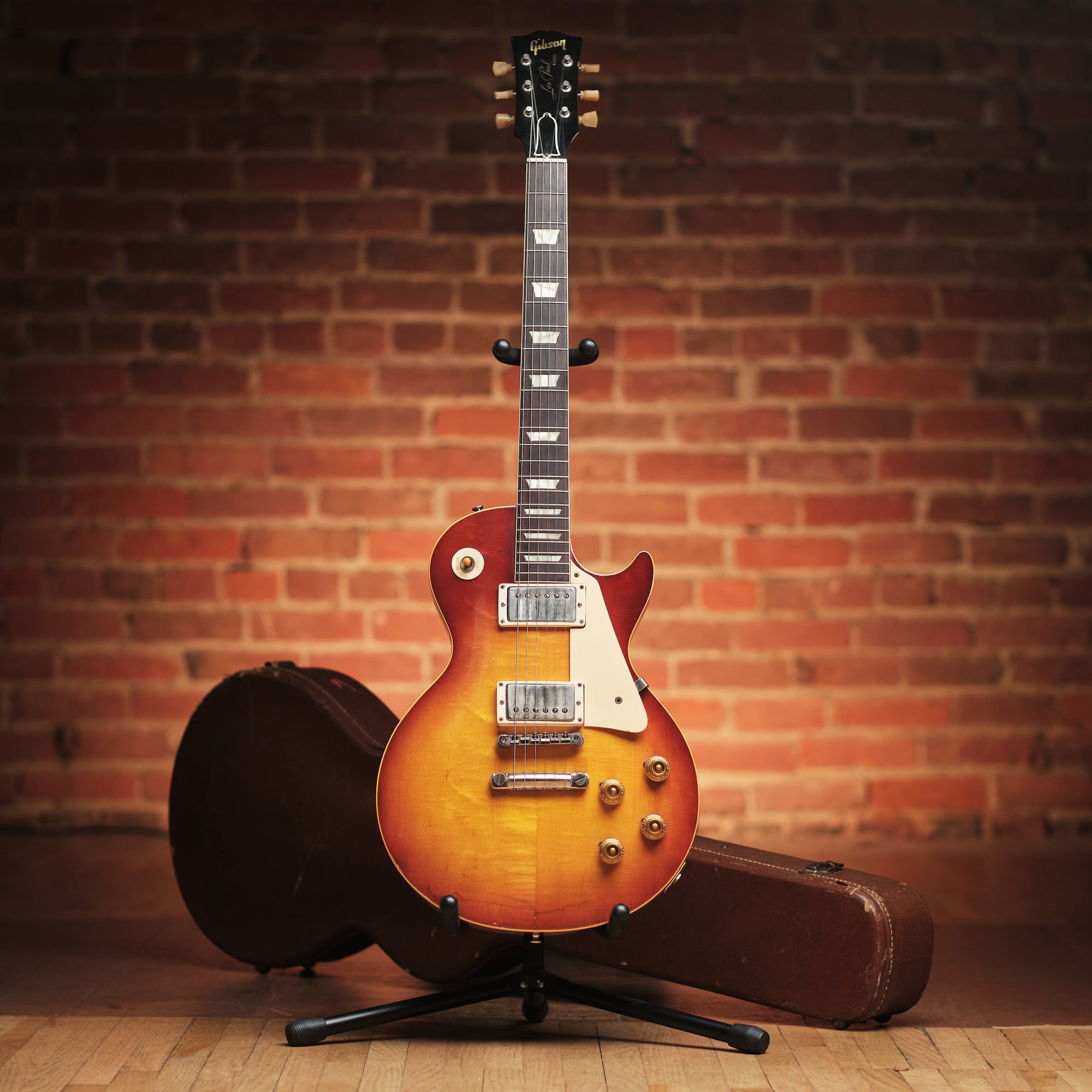1932 Martin OM-28

The OM is another Martin model that was begrudgingly deigned, just to go on to become one of the best-selling and most copied instruments of all time. The idea of a 14-fret acoustic guitar had been brewing in the marketplace for some time come the late 20s, but Martin was insistent on the superiority of their 12-fret 000. In a 1927 letter written by a dealer to Martin, a customer request was made for a 000 sized guitar with extended access to the higher frets. Their response? An abject denial of this request and further insistence that modifying the shape of the 000 would result in an inferior instrument which Martin could never make available to the public in good conscience. When former banjo-celebrity-turned-guitar-virtuoso Perry Bechtel visited the factory two years later and made a similar request, CF Martin III fortunately gave a different answer.
The OM-28 is an exceptionally rare instrument, total production numbering well under 500 for its entire prewar existence. Of those, only 50 were built in 1932. Rare even among the rare. We may be inclined to think earlier is always better, but many modern features we know and love today were incubated in the early OMs, in many cases making the later guitars much more enjoyable to play. OMs built prior to April of 1930 were fitted with rectangular pyramid bridges. While aesthetically pleasing, the high tension of steel strings proved problematic for such a limited gluing surface, and thus the modern belly bridge was designed in its stead. The earliest OMs came equipped with banjo-style Grover tuners, another feature that fell to the relentless pull of steel strings. Even the pickguard became larger in order to better shield the finish from errant pick wear. All good things. This particular OM-28 has undergone some tasteful finish work on the top, but remains at full thickness and sounds exactly as it should. A bar-fretted cannon from the brightest point in Martin’s golden age.
2012 Martin D-45V

With all the fuss made about prewar Martins, (I take some responsibility for this) it’s refreshing to see that the company is still capable of building modern instruments with the same quality and attention to detail. D-45s from the initial run (’33-’42) are quite literally the #1 most expensive vintage guitars ever sold, and thus also rank similarly on the list of guitars most of us will never own. Some compromises need to be made then, and the D-45V is one hell of a consolation prize. The materials used are absolutely the best Martin has to offer, and when dealing with a company like Martin, one can be assured this means they are some of the best materials available anywhere. The East Indian rosewood back and sides are straight-grained and oily, very much similar to Brazilian from the early days. The ebony is jet-black and glassy. The tinted Sitka spruce top is tight-grained and perfectly quartered. This is as good as it gets for a modern guitar.
Much speculation has been made in modern times as well as in years past regarding the difference in sound between 28 and 45-style Martins. On paper one shouldn’t exist. Using identical materials and construction, only the ornamentation draws difference between the workhorse and the king. Over the years though, many keen-eared guitarists have sworn time and time again that the D-45s are discernible and superior when compared to 28s. Most have chalked this argument up to a simple case of post-purchase rationalization, but I disagree. The 45 benefits tonally from a construction principle used for generations on violins and other arched instruments. When carving the top of an instrument, it is widely accepted that the plate is thickest under the bridge, and thinnest slightly inside the edges of the top. This thin section towards the perimeter is called recurve, and it is what allows the top to vibrate freely while remaining strong enough to hold string tension. Recurve, intentionally or not, is what is simulated on style 45s. Cutting the channel for the pearl significantly thins the top just inside the body edge, liberating the top in a way not possible on a 28. Collings takes advantage of this principle by thinning their tops around the edges via sanding, but the result is similar. A more responsive instrument with a lot more flash. Come down and compare them for yourself, I think you’ll notice a difference.
1966 Gibson Tal Farlow

While Tal Farlow might not be a household name today, he remains one of my favorite figures in jazz guitar history. Not for his music, mind you, although he was a fabulously talented player; but rather for the manner in which he navigated his life. Tal picked up guitar for the first time at 22 years of age and received absolutely no formal training. Too poor to afford an electric guitar, he built his own. By age 28 (yes, only 6 years after teaching himself to play) he rose to worldwide prominence playing in the bands of Charles Mingus, Red Norvo, and Artie Shaw, among others. He remained one of the most in-demand players on the planet. In 1958, he got married and decided to retire. A true family man. So, like Lou Gehrig, Tal waved his hat and stepped away from a career most musicians would kill for. Always leave them wanting more. He promptly began his next career as a sign painter, another objectively cool vocation. In 1962, years after retiring from music, Gibson approached him about designing a signature model. He obliged, and drew up one of the most distinctive and tasteful signature models that would ever grace the Gibson catalog. After his career as a sign painter drew to close in his mid-50s, he began playing on recording sessions again just for fun, which he continued on a casual basis until his passing at age 77 from esophageal cancer. I think we can all agree, apart from the unfortunate throat cancer, Tal lived about the best life imaginable. For this, he is a personal hero of mine.
This particular example is one of the finest Tal Farlow models we’ve ever come across. Gorgeous flamed maple throughout exudes class, with the ever-distinctive faux-scroll standing out as a focal point. A pair of untouched “patent number” Gibson humbuckers live up to their momentous hype, and sound equally excellent clean or overdriven. This instrument was clearly a cherished possession, and shows only extremely light play wear throughout. Whether you admire Tal for his musical career, or like me for his life surrounding it, you’re unlikely to find a finer jazz box at any shop in the world.
1960 Fender Stratocaster

Without any exaggeration, this is one of our favorite Strats in the shop. We always have a bit of a soft spot for player grade instruments, but this one is particularly special even among many of the original examples in our inventory. The refinish obviously will keep this one out of the museums, but the rest of the guitar remains absolutely untouched apart from an extremely professional refret and replaced bone nut. The refinish was done by our friend and local legend Joe Riggio who is known the world over for his outstanding vintage finish work, this guitar being no exception. The refret and nut replacement are the work of Holger Notzel of Baton Rouge, another massively respected luthier whose main focus is on vintage instruments. There’s no funny business with this guitar.
What can I say about slab board Strats that I haven’t already? They’re a blue-chip Fender model and for good reason. The original pickups are extremely strong and well-balanced, providing tremendously usable sounds in all positions. The Strat bridge pickup is often overlooked because of its notoriously thin and tinny sound, but this particular pickup surprised us all with its fullness and warmth across all frequencies. The stunning Brazilian slab fretboard remains at its full thickness, and surely contributes to the snappy mids that are prominent with this instrument. The unplugged resonanace of this Strat is alarming when strummed without amplification, a quality that is only exaggerated when plugged in. Some folks say this is the best way to judge the quality of a vintage solid body guitar, and this one certainly affirms that theory.
1959 Guild M-75 ex. Walter Becker

Working at a high-profile vintage guitar shop, as you may guess, has a great deal of perks. Not the least of which being the virtual parade of legendary musicians that make their way through our doors on a regular basis. One of our favorites over the years has been the iconic Walter Becker, famously one of the founding members of Steely Dan. He had a habit over the years of coming down to the shop a few minutes before closing time, and spending the following several hours dazzling our after-hours crew with his virtuosic guitar playing. All the while drinking Coca-Cola like it was going out of style. He would come to be known mostly as a Strat player throughout his career, but his choice of gear while in the shop was always refreshingly agnostic. He had a unique proclivity to pull the best sounds out of whatever rig he was given, and operated largely on feel rather than any sort of brand recognition. He purchased an impressive number of guitars from us over the years, always tremendous instruments but rarely one you’d expect. In this way, this ’59 M-75 is a perfect representation of the Walter we knew both as a client and as a friend.
One of Guild’s many underrated models from the middle of the last century, the M-75 offers a combination of features you’d struggle to find elsewhere. A fully hollow mahogany body topped with natural spruce make this an incredibly light and resonant instrument, all in a very manageable size no larger than a Les Paul. The pickups are Guild-designed single coils, much like a standard P-90 in construction but with a character all their own. This guitar has been in Walter’s personal collection since the 80s, and was extremely well loved and widely used in his home studio. It came to us directly from Walter’s former wife, and includes a personal letter from her describing his relationship with this specific guitar If you’re looking for an amazing piece of Steely Dan history, this is an ideal piece. If you’re looking for a sensational player’s instrument that will inspire you for years to come, this is an ideal instrument.



